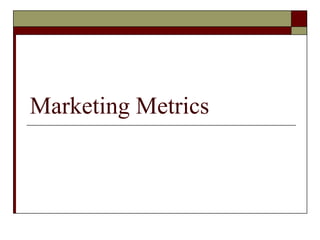Marketing metrics control@5 5-07-to be distributed
- 2. What/Why Are Marketing Metrics Used In order to assess: The success of a marketing plan Our ability to deliver marketing objectives/goals To re-affirm/reinforce resource allocation for a project Compare actual performance vs. planned performance of marketing dept.
- 3. Why is Control in Marketing Planning Important Monitor progress Understand discrepancies Provide direction in understanding where discrepancy occurs Product mix or pricing Provides information on whether resources must be shifted/re-allocated Helps understand if objectives need changing Provides recognition of changing environmental conditions/dynamics
- 4. What Are The Steps in Control Measure actual performance Compare performance to actual established marketing objectives or strategies Make adjustments to objectives or strategies based on analysis
- 5. What Are Common Metrics Cost of a prospect Value of a prospect ROI of a campaign Value of telesales Conversion rates of users of competitive products Referral rates Response rates to direct marketing Brand awareness Perceived service/product quality Customer turnover Market share Amount sold on promotion Reach and frequency of advertising Recognition/recall of advertising Sales calls/day Order fulfillment efficiency Customer satisfaction
- 6. What Are Common Metrics Gross Margin: Subtract cost of goods sold from gross or net sales (depending on your company) WhatŌĆÖs left over is gross margin on sales. Why is it important: It covers all of the other operating expenses and hopefully enough is left over to result in a respectable bottom line profit. If gross margin is low, then the company should have high inventory turnover (grocery store) If gross margin is high, inventory is probably held a long time (i.e. furniture)
- 7. Working Capital Also called working capital How is it measured Working capital = current assets ŌĆō current liabilities Usually current assets (cash, inventory, accounts receivables) Current liabilities (accounts payable) Why is it important: Can the company meet its day-to-day liquidity demands Is money tied up inventory Reflects a companyŌĆÖs efficiency and its immediate term health Are you managing your inventory, your customers and your suppliers? How well is the firm minimizing its inventory, collecting its account receivables and pro-longing its accounts payables (liabilities)
- 8. Break Even Analysis Frequently used to study the impact of changes in price, fixed cost, and variable cost on profit. Calculation: Break even point = (fixed cost)/ (unit price ŌĆō unit variable cost) Value: Answers, how much do I have to sell or what expenses do I need to minimize in order to make a profit Analyzes relationship between total revenue and total cost to determine profitability at various levels of output. Reflect quantity at which total revenue and total cost are equal and beyond which profit occurs.
- 9. Two Break Even Analyses The Only Difference is Fixed Cost
- 10. Look How Fixed Cost Shifts The Break Even Point
- 11. Price Elasticity of Demand How responsive demand is to price changes Cigarettes and gas: Inelastic Commodities: Elastic Measured by percentage change in quantity demanded relative to a percentage change in price. Formula
- 12. Mark-Up On Cost vs. Mark-Up on Selling How much a manufacturer makes How much a retailer makes
- 13. Return on Marketing Investment How an investment in marketing has an impact on the firmŌĆÖs success Calculation may vary on firm an industryq ROI = Return/Investment Return = profit Investment = sources of capital (expenditure)













